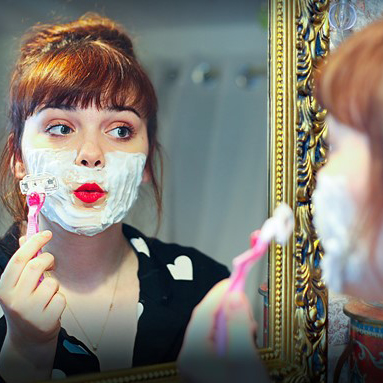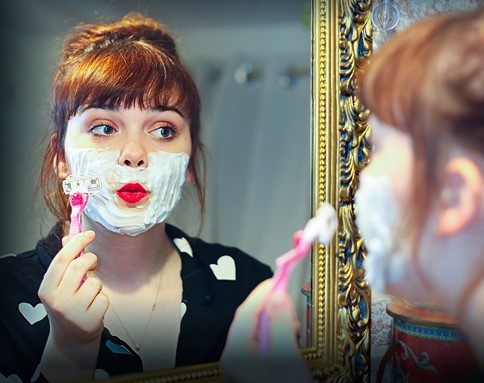Having velvety smooth skin on the face and legs is, for many, a gender-affirming choice. When exploring male to female tips for hair removal to improve your female appearance, it’s important you get the right advice on what to do as well as advice on what NOT to do. Options open to you will depend a lot on your life situation. If you are transitioning you will want to consider more permanent hair removal solutions like laser treatments. Whereas, crossdressers may well only be able to consider the use of the good old-fashioned shaver.
Remember, hair removal and skin care go hand in hand. Just shaving is not the solution to an authentic female appearance since it can lead to other issues when preparation and after-care like moisturizing and exfoliating are not done correctly.
MtF hair removal for many is a big confidence booster when done right. But remember, it is an individual choice. Not everyone will want or need hair removal. Always consider what makes you comfortable and then decide. For those who are considering hair removal, we’ll set out some sound advice so you do it right the first time.
Why It is Important to Exfoliate Your Skin In between Hair Removal?
Not only does regular exfoliation lead to healthier and smoother skin, but it also guards against irritation and ingrown hairs. Done properly, it will mean less nicks and irritations after the shave so that your face and leg skin will be much calmer prior to and after shaving.
When is the best time to exfoliate – before or after shaving? Exfoliation should always be carried out prior to shaving and never immediately afterwards. Shaving can irritate skin, particularly on the sensitive face and exfoliating after shaving can irritate it further. So, always exfoliate before you shave.
Soak in a bath or shower to allow warm water to soften the skin you are shaving before you exfoliate. The warm water helps soften the skin and the hair. For legs, use a loofah to exfoliate by using simple circular motions over the skin’s surface to remove dirt and dead skin cells. For the face, always use an exfoliating cream rather than a loofah. The facial skin is more sensitive and can be irritated with a loofah. Exfoliation will ensure a razor glides much more easily across the skin’s surface so you not only get a closer shave but less irritation.
Always Moisturize Before & After
Whilst shaving in itself is a method of exfoliation in removing not only hair but dead skin cells, it can lead to dry skin and irritation. There are certain safeguards in skin maintenance that will not only mean a smoother shave every time but also lead to healthier looking skin.
It’s important to soak the skin in a bath or shower prior to shaving. It not only opens up the pores but it also softens the hair follicles to ease the shaving process. Make sure the water is lukewarm and not hot. If water is too hot it dehydrates the skin. Always use a ‘hydrating’ shaving cream as a pre-moisturizer and you should never skip the cream and just use soap.
Immediately after you leave the bath or shower, pad dry the skin with a clean towel and apply a cream moisturizer. This is essential to rehydrating and ensuring a silky-smooth looking skin. This step should be repeated every time you shave, not just for special occasions.
Preventing In-Growing Hairs
In-grown hairs are one’s that literally grow back into the skin. They are more common in areas of the body that have curly and/or coarse hair though they occur anywhere, including the face. Causes can include dead skin cells blocking a hair follicle or a hair tip curling back and into the skin’s surface. In-grown hairs cause irritation to the skin’s surface with red bumps and spots, often itching and irritation.
A skin care regimen is essential to minimizing in-growing hairs. As outlined previously, regular exfoliation will decrease the chance of in-grown hairs, as will proper shaving technique. If in-grown hairs persist and they become irritated we would recommend a visit to a dermatologist.
Hair Removal with a Razor or Shaver
There are some really good electric shavers on the market now that can save you both time and money in the long run, rather than having to wet shave legs every time. Just remember not to skip the exfoliation or moisturizing steps as part of the overall skin care.
However, when it comes to the face we would always recommend a close wet shave as the best hair removal method. An electric shave, for most, just cannot get a close enough shave, especially when you will be following up with a makeup application.
For the best results when wet shaving:
- Always exfoliate before shaving
- Hydrate the skin with warm water before shaving
- Always use a hydrating shave gel or cream
- Use a sharp clean blade everytime
- Shave in the direction of the hair growth
- Rinse the blade each time between strokes
- Rinse off with cool water to soothe the skin
- Remember to moisturize but with non-greasy cream
Always shave with a light touch so you do not nick the skin’s surface.
Hair Removal Creams and At Home Treatments
Aside from shaving, the other main method of hair removal for the body that can be safely carried out in the home is hair removal creams. These are best for other parts of the body like the legs and are not intended for the face. For a crossdressing hair removal method it is perfect. It is affordable, quick, pain free compared to waxing or plucking and will not cut or nick the skin’s surface.
Most hair removal creams work by dissolving the hair which can then be wiped away or showered off only minutes after application. This allows you to save even more time. You can apply the cream to the legs and whilst it gets to work you can wet shave your face before getting into the shower to rinse off the hair removal cream and the now dissolved leg hair.
You should always ‘patch test’ the cream on a small section of skin first to ensure it does not irritate the skin prior to using it on the legs, for example.
Waxing Hair Removal
A common misconception of mtf hair removal is that waxing is much more painful than shaving and so many just won’t consider it. However, this is not necessarily the case, depending on who you ask. Sure, someone with a very sensitive skin may well feel pain and tenderness with waxing, but they probably will with shaving too. So why consider waxing as a hair removal method? Quite simply, because the result lasts for weeks rather than just hours or days of the conventional shaving method.
The main difference between waxing and traditional shaving is with waxing you remove the whole hair, including the root. With shaving you simply cut the hair off at the follicle. This explains why some feel more pain – similar to plucking. By removing the whole hair though, it often leads to thinning hair in the long run
Whilst not as expensive as a hair removal method as electrolysis, for example, waxing is best done by a pro in a salon and is more expensive than hair removal creams or shaving.
Laser Hair Removal
For transgender girls and crossdressers looking for a much longer lasting hair removal solution there are options but they invariably include more time and more money to get those long-lasting results.
Laser hair treatment has become very popular in recent times as a method of mtf hair removal. Laser application involves the heating of the actual hair follicles to radically reduce new hair growth. The results of such treatment inhibits for much longer periods of time, hair growth versus shaving or waxing, for example. It does not however, permanently stop hair growth.
For clients we speak to who have tried laser, it is certainly considered the best option for hair removal. It radically reduces hair growth over time, it’s rarely painful when done by a professional, is fast and most claim to see great results after 4 to 6 treatments.
The downside is the cost, time taken overall in that you need to rest 3 to 6 weeks between treatments and it appears to be less effective in darker skinned individuals.
Professional Treatments vs Hair Removal at Home
Given the most common hair removal methods for crossdressers and transgender femmes where is best to carry out the treatments? Obviously cost is a big consideration along with frequency. If you are a 4 times a year crossdresser then we would say the most effective solutions for you are at home hair removal using products readily available like wet shaving or hair removal creams.
For transgender girls presenting 24/7 then more longer-lasting methods like waxing or laser come in to play. Always consider that although salon visit treatments are more expensive, they tend to be more effective when carried out by a professional in a controlled space. They will also be more precise and effective than what you may be able to achieve on your own at home.
For those girls who cannot remove hair from legs there is always opaque hosiery to hide leg hair. Similarly, use long sleeves or sleeves made of semi-sheer material that will mask male hair. You can also wear an opaque bodystocking to cover most hairy parts!
For more on femme tips and advice, check out our blog with tons of articles to help you along your way. Know any great salons for effective hair removal that welcome our community, then let us know where they are? What tips do you have for your fellow girls? Email us at glambmarketing@gmail.com or message us on our Facebook page.

